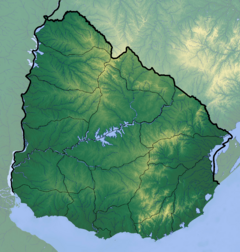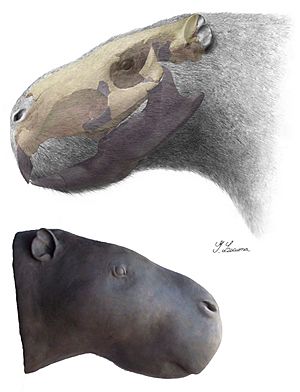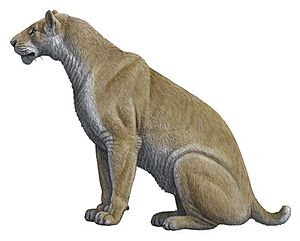Josephoartigasia facts for kids
Quick facts for kids Josephoartigasia |
|
|---|---|
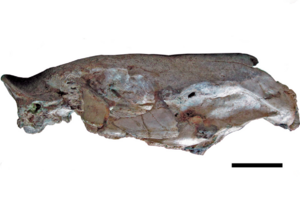 |
|
| J. monesi skull, scale = 10 cm (3.9 in) | |
| Scientific classification |
|
| Kingdom: | Animalia |
| Phylum: | Chordata |
| Class: | Mammalia |
| Order: | Rodentia |
| Family: | Dinomyidae |
| Genus: | †Josephoartigasia Francis and Mones, 1966 |
| Type species | |
| †Artigasia magna |
|
| Species | |
|
|
Josephoartigasia was a giant rodent that lived a long time ago. It is now extinct, meaning it no longer exists. This amazing animal lived in Uruguay from about 3 million to 2 million years ago. It belongs to a group of rodents called Dinomyidae. The only living animal in this group today is the pacarana, which is much smaller.
Josephoartigasia was named after José Artigas, a hero from Uruguay. Scientists have found two types, or species, of this giant rodent. The first, J. magna, was found in 1966. The second, J. monesi, was found in 2008. This second species had a nearly complete skull. Both types were found near Kiyú beach in Uruguay.
The skull of J. monesi was huge, about 53 cm (1 ft 9 in) long. This is similar in size to a beef cow's skull! Scientists think J. monesi weighed around 480–500 kg (1,060–1,100 lb). This makes it the biggest rodent ever found. It was much larger than the biggest living rodent today, the capybara, which weighs about 60 kg (130 lb).
J. monesi also had an incredibly strong bite. Its front teeth, called incisors, could bite with a force of about 1,400 N (310 lbf). This is as strong as a bite from a large meat-eating animal. Its back teeth, or molars, could bite with a force of 5,000 N (1,100 lbf). This is as strong as a large crocodilian's bite! Its skull was very strong. This suggests it used its teeth for more than just eating. It might have cracked nuts, dug large burrows, or pulled up roots. It also likely used its strong bite to defend itself from predators.
Josephoartigasia lived in a forest near water, like a river mouth. Other animals living there included toxodontids, ground sloths, glyptodonts, scimitar-toothed cats, terror birds, and thylacosmilids. Like other giant rodents, Josephoartigasia mostly ate soft plants like leaves or fruits. But its super strong bite meant it could eat many different kinds of plants if needed.
Contents
Discovering the Giant Rodent
The first fossils of this giant rodent were found in Uruguay. They were discovered at the Barrancas de San Gregorio, which are sea cliffs near Kiyú beach. The first fossil was a piece of a lower jaw, found in 1965. It had part of an incisor, a premolar, and two molars.
In 1966, two Uruguayan scientists, Julio César Francis and Álvaro Mones, studied this fossil. They named it a new genus and species, Artigasia magna. The name honors José Artigas, a national hero. Magnus is a Latin word meaning "large."
Later, in 2007, Mones changed the genus name to Josephoartigasia. This was because the name Artigasia was already used for a type of worm. So, a new name was needed for the giant rodent.
In 2008, another species, J. monesi, was described. This was based on a huge, almost complete skull. It was also found at the Barrancas de San Gregorio. The name monesi honors Álvaro Mones for his work. This skull was actually found in 1987. It was kept at the National Museum of Natural History, Uruguay. A curator named Andrés Rinderknecht found it there and studied it.
How Scientists Classify Josephoartigasia
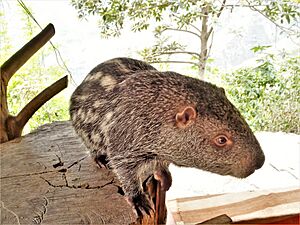
Josephoartigasia belongs to the animal family called Dinomyidae. This group of rodents lives in South America. The only living member of this family is the pacarana. Pacaranas are one of the largest living rodents, weighing about 15 kg (33 lb).
Scientists divide the Dinomyidae family into smaller groups called subfamilies. Josephoartigasia is part of the Eumegamyinae subfamily. This subfamily includes the biggest rodents in the Dinomyidae family.
It can be hard for scientists to classify these animals. Many dinomyid species are only known from small pieces of teeth and jaws. This makes it difficult to understand how they are all related.
When Josephoartigasia Lived
Scientists have studied the rocks where Josephoartigasia fossils were found. These rocks are part of the San José Member of the Raigón Formation. This area is in Uruguay.
The San José Member is dated to the Late Pliocene and Early Pleistocene periods. This means Josephoartigasia lived around 3 to 2 million years ago. The rocks show that the area had rivers and streams. It also had layers of sand, clay, and small rocks.
The skull of J. monesi was found right in these rocks. This helped scientists confirm its age.
What Josephoartigasia Looked Like
Teeth of the Giant Rodent
Josephoartigasia had a specific set of teeth. It had one incisor (front tooth) on each side of its upper and lower jaws. It had no canine teeth. It had one premolar and three molars on each side of its upper and lower jaws. Like other rodents, its incisors grew continuously throughout its life. There was a large gap between its incisors and its grinding teeth (premolars and molars).
Grinding Teeth
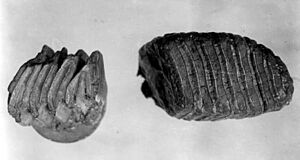
The molars of Josephoartigasia were packed tightly together. They had smooth, curved ridges called lophs on their biting surface. The back lophs had thick tooth enamel, but the front lophs had very little. This special enamel pattern is a key feature of Josephoartigasia.
In J. monesi, the grinding teeth were all about the same size. Each one had a grinding surface of about 24 cm2 (3.7 sq in). They each had five lophs.
Incisors
The incisors were long and wide. In J. magna, the known incisor was broken into two pieces. It was triangular but became flat at the tip. In J. monesi, only the base of one incisor is known.
The incisors of J. monesi were angled forward instead of pointing straight down. This angle made them very strong. It helped them resist bending when the animal bit down hard.
Skull of J. monesi
J. monesi is the only species of Josephoartigasia for which a skull has been found. Its skull was huge, measuring 53 cm (1 ft 9 in) long. This is even bigger than the skull of Phoberomys pattersoni, which was thought to be the largest rodent before.
Many bones in its skull were fused together. For example, the nasal and frontal bones were hard to tell apart. This fusion made the skull very strong. It had a tall ridge on top of its skull called a temporal crest. This crest helped anchor its powerful jaw muscles.
J. monesi had the deepest attachment point for the masseter muscle. This muscle helps close the mouth when biting. This strong muscle attachment is similar to that of the large capybara. This might be because they are related or because both animals became very big.
The cheekbones of J. monesi were surprisingly thin. This is unusual for such a strong skull. Like other Dinomyids, its skull had extra bumps where the spine connected. These bumps helped with muscle attachments.
Scientists think J. monesi might have had limited vision. This is because the opening for its optic nerve (which controls vision) was small.
How Big Was Josephoartigasia?
J. monesi was the first Dinomyid found with a nearly complete skull. This allowed scientists to estimate its size. It was much larger than J. magna.
In 2008, scientists estimated J. monesi could have weighed between 468–2,568 kg (1,032–5,661 lb). The average estimate was about 1,211 kg (2,670 lb). This made it the largest rodent ever discovered. The largest living rodent, the capybara, only weighs about 60 kg (130 lb).
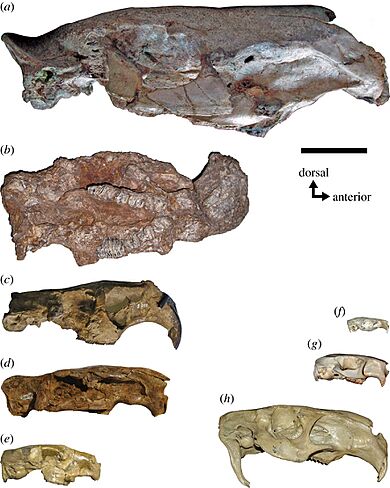
Scale = 10 cm (3.9 in)
Later, in 2022, another scientist, Russell Engelman, re-estimated its size. He used the width of the skull where it connects to the spine. He found that J. monesi likely weighed between 254–576 kg (560–1,270 lb). He suggested that 480–500 kg (1,060–1,100 lb) was the most likely weight. Even with these lower estimates, Josephoartigasia is still the largest rodent ever found.
What Josephoartigasia Ate and How It Used Its Teeth
Bite Force and Uses
In 2012, scientists estimated the bite force of J. monesi. Its incisors could bite with a force of about 959 N (216 lbf). This is similar to the bite force of large predators like a polar bear or a jaguar.
In 2015, more studies showed its maximum bite force. At its incisors, it could bite with 967–1,850 N (217–416 lbf) of force. At its third molar, the force could be as high as 2,914–5,534 N (655–1,244 lbf). This molar bite force is as strong as the bite of the largest crocodilians!
The skull of Josephoartigasia was built to withstand even more stress than its bite could create. This means it used its teeth for more than just eating. Its strong, angled incisors and reinforced skull suggest it used its teeth to dig. It might have dug up roots or made large burrows. Scientists have found huge burrows in South America. Josephoartigasia could have made them.
Its powerful incisors were also likely used for defense. It could have fought off predators like terror birds and large meat-eating marsupials.
Diet
Scientists first thought J. monesi ate mostly soft plants and fruits. This was because it seemed to live in a watery environment. They also thought its chewing muscles were weak.
However, after calculating its huge bite force, they changed their minds. This strong bite would have let it eat many different kinds of food, both hard and soft. Its incisors might have been used to dig up roots, much like how elephants use their tusks.
Studies of its tooth enamel show that Josephoartigasia ate only C3 plants. These are plants like leaves or fruits. Modern capybaras also prefer C3 plants. But they will eat other plants if food is scarce. Josephoartigasia might have done the same.
Where Josephoartigasia Lived
Josephoartigasia lived in the San Jose Member of the Raigón Formation in Uruguay. This area was likely a forested environment near water, like an estuary.
Many other animals lived alongside Josephoartigasia. These included:
- Giant plant-eaters like toxodontids and ground sloths.
- Armored animals called glyptodonts.
- Birds like the darter bird Giganhinga and large terror birds.
- Other rodents like the capybara Cardiatherium talicei.
- Predators such as scimitar-toothed cats.
- Even a vampire bat called Desmodus draculae.
During the time Josephoartigasia lived, the climate in Uruguay changed. It went from dry to warmer and more humid. This change caused forests to grow more.
See also
 In Spanish: Josephoartigasia para niños
In Spanish: Josephoartigasia para niños


